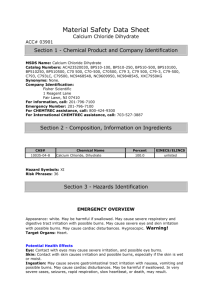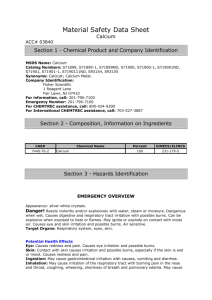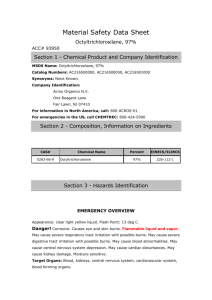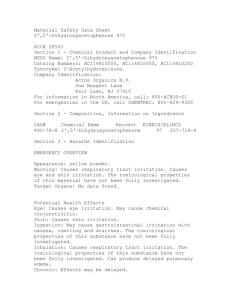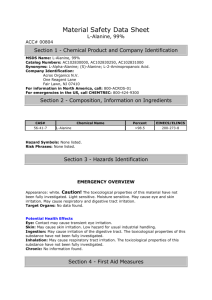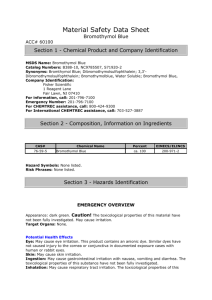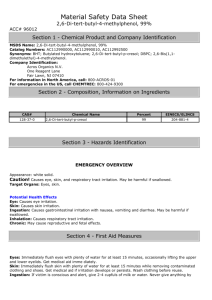Material Safety Data Sheet
advertisement
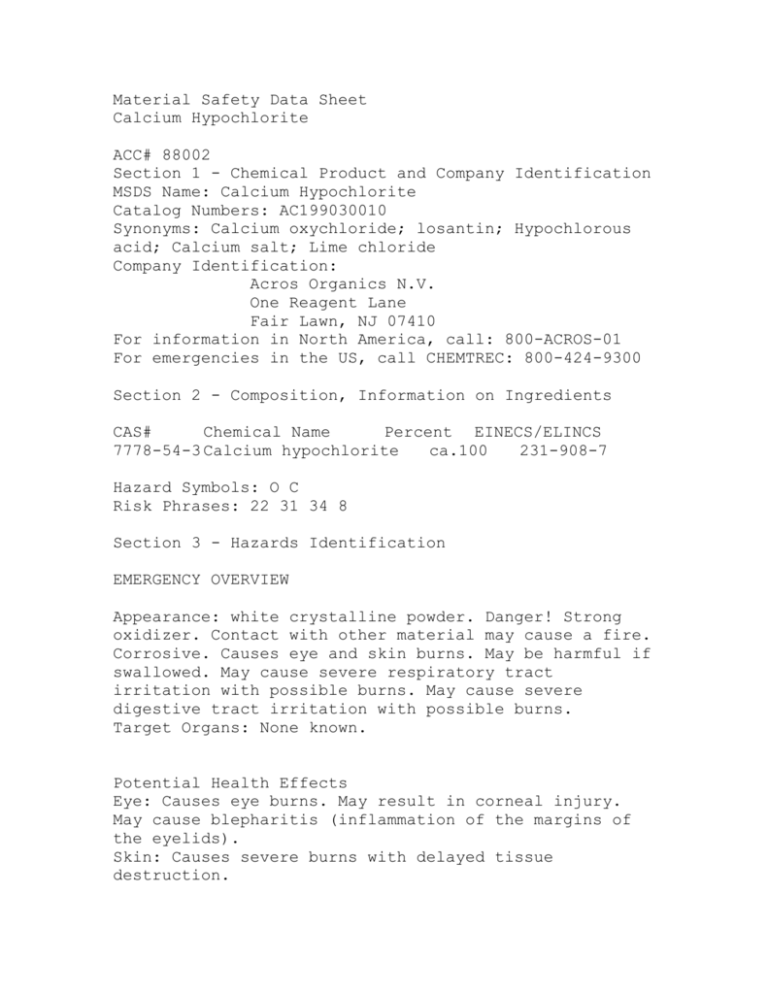
Material Safety Data Sheet Calcium Hypochlorite ACC# 88002 Section 1 - Chemical Product and Company Identification MSDS Name: Calcium Hypochlorite Catalog Numbers: AC199030010 Synonyms: Calcium oxychloride; losantin; Hypochlorous acid; Calcium salt; Lime chloride Company Identification: Acros Organics N.V. One Reagent Lane Fair Lawn, NJ 07410 For information in North America, call: 800-ACROS-01 For emergencies in the US, call CHEMTREC: 800-424-9300 Section 2 - Composition, Information on Ingredients CAS# Chemical Name Percent EINECS/ELINCS 7778-54-3 Calcium hypochlorite ca.100 231-908-7 Hazard Symbols: O C Risk Phrases: 22 31 34 8 Section 3 - Hazards Identification EMERGENCY OVERVIEW Appearance: white crystalline powder. Danger! Strong oxidizer. Contact with other material may cause a fire. Corrosive. Causes eye and skin burns. May be harmful if swallowed. May cause severe respiratory tract irritation with possible burns. May cause severe digestive tract irritation with possible burns. Target Organs: None known. Potential Health Effects Eye: Causes eye burns. May result in corneal injury. May cause blepharitis (inflammation of the margins of the eyelids). Skin: Causes severe burns with delayed tissue destruction. Ingestion: May cause severe and permanent damage to the digestive tract. Causes gastrointestinal tract burns. May cause perforation of the digestive tract. May be harmful if swallowed. Inhalation: Causes chemical burns to the respiratory tract. Aspiration may lead to pulmonary edema. May cause systemic effects. Causes corrosive action on the mucous membranes. Chronic: Prolonged or repeated skin contact may cause dermatitis. Prolonged or repeated eye contact may cause conjunctivitis. Effects may be delayed. Laboratory experiments have resulted in mutagenic effects. Section 4 - First Aid Measures Eyes: Get medical aid immediately. Do NOT allow victim to rub or keep eyes closed. Extensive irrigation with water is required (at least 30 minutes). Skin: Get medical aid immediately. Immediately flush skin with plenty of water for at least 15 minutes while removing contaminated clothing and shoes. Wash clothing before reuse. Destroy contaminated shoes. Ingestion: Do NOT induce vomiting. If victim is conscious and alert, give 2-4 cupfuls of milk or water. Never give anything by mouth to an unconscious person. Get medical aid immediately. Inhalation: Get medical aid immediately. Remove from exposure and move to fresh air immediately. If breathing is difficult, give oxygen. Do NOT use mouthto-mouth resuscitation. If breathing has ceased apply artificial respiration using oxygen and a suitable mechanical device such as a bag and a mask. Notes to Physician: Treat symptomatically and supportively. Section 5 - Fire Fighting Measures General Information: As in any fire, wear a selfcontained breathing apparatus in pressure-demand, MSHA/NIOSH (approved or equivalent), and full protective gear. Strong oxidizer. Contact with combustible materials may cause a fire. During a fire, irritating and highly toxic gases may be generated by thermal decomposition or combustion. Use water spray to keep fire-exposed containers cool. Use water with caution and in flooding amounts. Contaminating or mixing with foreign materials such as combustibles, grease, and fuels can cause fire. Containers may explode when heated. Extinguishing Media: Use water spray to cool fireexposed containers. Contact professional fire-fighters immediately. Cool containers with flooding quantities of water until well after fire is out. For small fires, do NOT use dry chemicals, carbon dioxide, halon or foams. USE WATER ONLY. For large fires, flood fire area with water from a distance. Flash Point: Not available. Autoignition Temperature: Not available. Explosion Limits, Lower:Not available. Upper: Not available. NFPA Rating: (estimated) Health: 3; Flammability: 0; Instability: 1; Special Hazard: OX Section 6 - Accidental Release Measures General Information: Use proper personal protective equipment as indicated in Section 8. Spills/Leaks: Vacuum or sweep up material and place into a suitable disposal container. Avoid runoff into storm sewers and ditches which lead to waterways. Clean up spills immediately, observing precautions in the Protective Equipment section. Avoid generating dusty conditions. Remove all sources of ignition. Provide ventilation. Do not get water inside containers. Do not use combustible materials such as paper towels to clean up spill. Section 7 - Handling and Storage Handling: Wash thoroughly after handling. Remove contaminated clothing and wash before reuse. Use only in a well-ventilated area. Minimize dust generation and accumulation. Do not get in eyes, on skin, or on clothing. Keep container tightly closed. Avoid contact with heat, sparks and flame. Avoid contact with clothing and other combustible materials. Do not ingest or inhale. Discard contaminated shoes. Storage: Keep away from heat, sparks, and flame. Keep away from sources of ignition. Do not store near combustible materials. Keep container closed when not in use. Store in a tightly closed container. Store in a cool, dry, well-ventilated area away from incompatible substances. Keep away from acids. Section 8 - Exposure Controls, Personal Protection Engineering Controls: Facilities storing or utilizing this material should be equipped with an eyewash facility and a safety shower. Use adequate ventilation to keep airborne concentrations low. Exposure Limits Chemical Name ACGIH NIOSH OSHA - Final PELs Calcium hypochlorite none listed none listed none listed OSHA Vacated PELs: Calcium hypochlorite: No OSHA Vacated PELs are listed for this chemical. Personal Protective Equipment Eyes: Wear appropriate protective eyeglasses or chemical safety goggles as described by OSHA's eye and face protection regulations in 29 CFR 1910.133 or European Standard EN166. Skin: Wear appropriate protective gloves to prevent skin exposure. Clothing: Wear appropriate protective clothing to prevent skin exposure. Respirators: A respiratory protection program that meets OSHA's 29 CFR 1910.134 and ANSI Z88.2 requirements or European Standard EN 149 must be followed whenever workplace conditions warrant a respirator's use. Section 9 - Physical and Chemical Properties Physical State: Crystalline powder Appearance: white Odor: strong odor - chlorine-like pH: Not available. Vapor Pressure: Not applicable. Vapor Density: Not applicable. Evaporation Rate:Not applicable. Viscosity: Not available. Boiling Point: Decomposes Freezing/Melting Point:100 deg C Decomposition Temperature:175 deg C Solubility: Slightly soluble. Specific Gravity/Density:2.350 Molecular Formula:CaCl2O2 Molecular Weight:142.9848 Section 10 - Stability and Reactivity Chemical Stability: Stable at room temperature in closed containers under normal storage and handling conditions. Conditions to Avoid: High temperatures, incompatible materials, ignition sources, dust generation, acids, excess heat, combustible materials, organic materials, reducing agents. Incompatibilities with Other Materials: Reducing agents, carbontetrachloride, ammonia, alliphatic amines, aromatic amines, sulfur, sulfides (inorganic, e.g. ferric sulfide, lead sulfide, sodium sulfide), metal oxides, glycerol, phenols, diethylene glycol monomethyl ether, carbon, acetic acid + potassium, cyanides (e.g. potassium cyanide, sodium cyanide), ammonium chloride, charcoal, N,N-dichloromethylamine + heat, ethanol, menthol, iron oxide, rust, 1propanethiol, isobutanethiol, turpentine, sodium hydrogen sulfate + starch + sodium carbonate, acetylene, hydroxy compounds (e.g. ethanol, ethylene glycol, gycerol, sugar), combustible materials (e.g. anthracene, grease, oil, mercaptans, methyl carbitol, nitromethane, organic matter, and propylmercaptan). Hazardous Decomposition Products: Hydrogen chloride, irritating and toxic fumes and gases, oxygen, chlorine. Hazardous Polymerization: Has not been reported. Section 11 - Toxicological Information RTECS#: CAS# 7778-54-3: NH3485000 LD50/LC50: CAS# 7778-54-3: Oral, rat: LD50 = 850 mg/kg; Carcinogenicity: CAS# 7778-54-3: Not listed by ACGIH, IARC, NIOSH, NTP, or OSHA. Epidemiology: No information available. Teratogenicity: No information available. Reproductive Effects: No information available. Neurotoxicity: No information available. Mutagenicity: Mutation in Microorganisms: Salmonella typhimurium = 1 mg/plate.; Cytogenetic Analysis: Hamster, Fibroblast = 4 gm/L. Other Studies: No data available. Section 12 - Ecological Information Ecotoxicity: Fish: Striped bass: LC50 = 0.5 mg/L; 24 Hr; Static bioassay (70% hypochlorite) Section 13 - Disposal Considerations Chemical waste generators must determine whether a discarded chemical is classified as a hazardous waste. US EPA guidelines for the classification determination are listed in 40 CFR Parts 261.3. Additionally, waste generators must consult state and local hazardous waste regulations to ensure complete and accurate classification. RCRA P-Series: None listed. RCRA U-Series: None listed. Section 14 - Transport Information US DOT IATA RID/ADR IMO Canada TDG Shipping Name: CALCIUM HYPOCHLORITE, DRY No information available. Hazard Class: 5.1 UN Number: UN1748 Packing Group: II Section 15 - Regulatory Information US FEDERAL TSCA CAS# 7778-54-3 is listed on the TSCA inventory. Health & Safety Reporting List None of the chemicals are on the Health & Safety Reporting List. Chemical Test Rules None of the chemicals in this product are under a Chemical Test Rule. Section 12b None of the chemicals are listed under TSCA Section 12b. TSCA Significant New Use Rule None of the chemicals in this material have a SNUR under TSCA. SARA CERCLA Hazardous Substances and corresponding RQs CAS# 7778-54-3: 10 lb final RQ; 4.54 kg final RQ SARA Section 302 Extremely Hazardous Substances None of the chemicals in this product have a TPQ. SARA Codes CAS # 7778-54-3: acute, flammable. Section 313 No chemicals are reportable under Section 313. Clean Air Act: This material does not contain any hazardous air pollutants. This material does not contain any Class 1 Ozone depletors. This material does not contain any Class 2 Ozone depletors. Clean Water Act: CAS# 7778-54-3 is listed as a Hazardous Substance under the CWA. None of the chemicals in this product are listed as Priority Pollutants under the CWA. None of the chemicals in this product are listed as Toxic Pollutants under the CWA. OSHA: None of the chemicals in this product are considered highly hazardous by OSHA. STATE CAS# 7778-54-3 can be found on the following state right to know lists: California, New Jersey, Pennsylvania, Massachusetts. California No Significant Risk Level: None of the chemicals in this product are listed. European/International Regulations European Labeling in Accordance with EC Directives Hazard Symbols: O C Risk Phrases: R 22 Harmful if swallowed. R 31 Contact with acids liberates toxic gas. R 34 Causes burns. R 8 Contact with combustible material may cause fire. Safety Phrases: S 1/2 Keep locked up and out of reach of children. S 26 In case of contact with eyes, rinse immediately with plenty of water and seek medical advice. S 45 In case of accident or if you feel unwell, seek medical advice immediately (show the label where possible). S 43J In case of fire, use water. Do not use dry chemicals or foams. CO2 or Halon my provide limited control. WGK (Water Danger/Protection) CAS# 7778-54-3: 2 Canada - DSL/NDSL CAS# 7778-54-3 is listed on Canada's DSL List. Canada - WHMIS WHMIS: Not available. Canadian Ingredient Disclosure List Exposure Limits Section 16 - Additional Information MSDS Creation Date: 7/19/1999 Revision #2 Date: 7/19/2002 The information above is believed to be accurate and represents the best information currently available to us. However, we make no warranty of merchantability or any other warranty, express or implied, with respect to such information, and we assume no liability resulting from its use. Users should make their own investigations to determine the suitability of the information for their particular purposes. In no event shall Fisher be liable for any claims, losses, or damages of any third party or for lost profits or any special, indirect, incidental, consequential or exemplary damages, howsoever arising, even if Fisher has been advised of the possibility of such damages.
